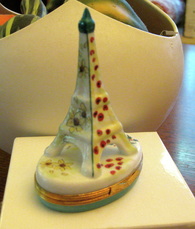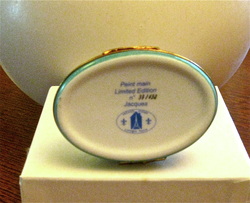- Welcome to The Wise Collector
- Knowledge Changes Everything!
- Buyer Beware!
- Buyer Beware!: Part II
- Caring for Your Antiques
- Coin Collecting
- McCoy Pottery
- Chinese Export Porcelain
- Frankoma Pottery
- The Arts and Crafts Movement
- Roycroft
- The Art Deco Period
- Susie Cooper Pottery
- Limoges China
- 18th C American Furniture Styles
- The Bauhaus School: Weimar 1919
- The Bauhaus School: Design & Architecture
- Portmeirion
- The End of a Century: Art Nouveau Style
- Biedermeier: The Comfortable Style
- The Souvenir Age
- A History of Ceramic Tiles
- Flow Blue China
- Collect Vintage Christmas Decorations
- An American Thanksgiving Through theYears
- How to Find an Antiques Appraiser
- Louis Prang, Father of the American Christmas Card
- Thomas Cook and the Grand Tours
- Harry Rinker's 25th Anniversary
- Mid-Century Modern
- Will Chintz China become Popular Again?
- Ireland's Waterford Crystal
- Vintage Wicker and Rattan
- Fishing Gear Collecting
- Bennington Pottery
- Identifying Pottery and Ceramic Marks
- The Art of Needlework in the Arts & Crafts Era
- The Delicious World of Vintage Cookbooks
- BLOG: RANDOM THOUGHTS
- E-BOOKS BY BARBARA BELL
- First Reader Consulting
Limoges Porcelain
The history of the fine porcelain now known as "Limoges" begins with kaolin, the pure, soft white clay first discovered in China. This clay retains its pure white color when fired. Before they discovered the pure white clay, the Chinese used sandstone/stoneware. Marco Polo was one of the first Europeans to see porcelain; he named it after very white and translucent shell. Vasco de Gama brought back the first porcelain objects to Europe in the fifteenth century .
How to Fix the Budget Deficit?
Louis XIV ordered all silver plate to be melted down to make coins. The dishes needed to be replaced by something else, and the result was immediate demand for porcelain from China. However, the pieces were very expensive. The State decided to find out how porcelain was made and an order went out that anybody who could discover the manufacturing process would be handsomely rewarded. The earliest deposits of the mineral required to make porcelain were discovered near Meissen, in Germany during the seventeenth century. Shortly thereafter, in 1768, Jean-Baptiste Darnet discovered kaolin at Clos de Barre, Saint-Yrieix-la-Perche, which was close to Limoges. (Limoges is the capital of Haute-Vienne in South Central France.) This discovery led to the foundation of the Limoges porcelain industry. Turgot, at that time Intendant of the Limousin area, recognized the economic potential for this rather poor region, where all the other elements necessary for this output were readily available. Underground deposits around Limoges also included metals which since the Middle Ages were used to provide metallic oxides for coloring enamel and faïence (high-relief pottery).
The first factories to produce porcelain in Limoges and Saint-Yrieix-la-Perche were set up in 1772 and protected by the Count of Artois. In 1771 the Faïence manufacture was converted into porcelain manufacture, and the region's first hard-paste porcelain began to be made. This initial factory became a subsidiary of the royal factory in Sèvres in 1784. After the French Revolution, there were no State-sponsored factories remaining, but private manufacturers continued the development of porcelain.
By the early nineteenth century the factories were creating the most perfectly white porcelain in Europe, proving the superiority of Limoges kaolins. By the 1830s there were as many as thirty porcelain factories at Limoges. The international renown of this center of porcelain excellence grew, culminating with the triumph of Limoges Porcelain at universal expositions organized around the world from 1855 onward.
The overwhelming majority of porcelain produced in Limoges was decorated by hand, by both well-known and anonymous artists. The best of the collectible hand-painted Limoges china has the artist's signature near the manufacturer's mark.
There are literally dozens of well-known manufacturers whose porcelain survives from the 18th, 19th and early 20th centuries. Some of the best known are Haviland (H&Co), T & V, Paroutaud Freres, Flambeau, Elite, and JP/L. The name "Limoges, France" usually appears, or the letter "L" beneath the name of the manufacturer.
Collectors will find that much Limoges china is modest in price. Individual, artist-signed, dinner or dessert plates may cost between $35 and $60, depending on condition. It is quite possible to find complete sets of dinnerware, breakfast or tea sets, candlesticks and jars, large chargers and tureens priced in the $200 to $500 range. While a great deal of fine china from other famous areas of France, Germany, Bavaria and Russia also survives from this period, Limoges has become very popular in the United States as the china our grandmothers received as brides.
Today, Limoges retains its popularity with the introduction of small hinged boxes in a fantastic variety of shapes and themes. Their prices are high because each is still hand-painted by local artisans, which unfortunately has resulted in just as many knock-offs from China and Taiwan. The cheap versions lack the fineness of detail and perfection of the construction. You get what you pay for!
Here are some great links for collectors of both old and new Limoges porcelains:
LimogesLovers.com - specializes in antique Limoges china. Excellent photos with back stamps, reasonable prices.
La Boutique de la Porcelaine de Limoges - A French site with a great deal of historical information as well as galleries, museum links, and sales.
Haviland Collectors Internationale Foundation - Organization for devotees of Haviland Limoges china, with newsletter, annual conference, and a limited gallery of photos.
How to Fix the Budget Deficit?
Louis XIV ordered all silver plate to be melted down to make coins. The dishes needed to be replaced by something else, and the result was immediate demand for porcelain from China. However, the pieces were very expensive. The State decided to find out how porcelain was made and an order went out that anybody who could discover the manufacturing process would be handsomely rewarded. The earliest deposits of the mineral required to make porcelain were discovered near Meissen, in Germany during the seventeenth century. Shortly thereafter, in 1768, Jean-Baptiste Darnet discovered kaolin at Clos de Barre, Saint-Yrieix-la-Perche, which was close to Limoges. (Limoges is the capital of Haute-Vienne in South Central France.) This discovery led to the foundation of the Limoges porcelain industry. Turgot, at that time Intendant of the Limousin area, recognized the economic potential for this rather poor region, where all the other elements necessary for this output were readily available. Underground deposits around Limoges also included metals which since the Middle Ages were used to provide metallic oxides for coloring enamel and faïence (high-relief pottery).
The first factories to produce porcelain in Limoges and Saint-Yrieix-la-Perche were set up in 1772 and protected by the Count of Artois. In 1771 the Faïence manufacture was converted into porcelain manufacture, and the region's first hard-paste porcelain began to be made. This initial factory became a subsidiary of the royal factory in Sèvres in 1784. After the French Revolution, there were no State-sponsored factories remaining, but private manufacturers continued the development of porcelain.
By the early nineteenth century the factories were creating the most perfectly white porcelain in Europe, proving the superiority of Limoges kaolins. By the 1830s there were as many as thirty porcelain factories at Limoges. The international renown of this center of porcelain excellence grew, culminating with the triumph of Limoges Porcelain at universal expositions organized around the world from 1855 onward.
The overwhelming majority of porcelain produced in Limoges was decorated by hand, by both well-known and anonymous artists. The best of the collectible hand-painted Limoges china has the artist's signature near the manufacturer's mark.
There are literally dozens of well-known manufacturers whose porcelain survives from the 18th, 19th and early 20th centuries. Some of the best known are Haviland (H&Co), T & V, Paroutaud Freres, Flambeau, Elite, and JP/L. The name "Limoges, France" usually appears, or the letter "L" beneath the name of the manufacturer.
Collectors will find that much Limoges china is modest in price. Individual, artist-signed, dinner or dessert plates may cost between $35 and $60, depending on condition. It is quite possible to find complete sets of dinnerware, breakfast or tea sets, candlesticks and jars, large chargers and tureens priced in the $200 to $500 range. While a great deal of fine china from other famous areas of France, Germany, Bavaria and Russia also survives from this period, Limoges has become very popular in the United States as the china our grandmothers received as brides.
Today, Limoges retains its popularity with the introduction of small hinged boxes in a fantastic variety of shapes and themes. Their prices are high because each is still hand-painted by local artisans, which unfortunately has resulted in just as many knock-offs from China and Taiwan. The cheap versions lack the fineness of detail and perfection of the construction. You get what you pay for!
Here are some great links for collectors of both old and new Limoges porcelains:
LimogesLovers.com - specializes in antique Limoges china. Excellent photos with back stamps, reasonable prices.
La Boutique de la Porcelaine de Limoges - A French site with a great deal of historical information as well as galleries, museum links, and sales.
Haviland Collectors Internationale Foundation - Organization for devotees of Haviland Limoges china, with newsletter, annual conference, and a limited gallery of photos.
Web Hosting by iPage. The copyright of the articles in The Wise Collector is owned by Barbara Nicholson Bell. Permission to republish any articles herein online or in print must be granted by the author in writing.

